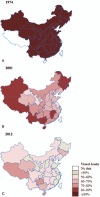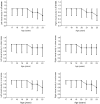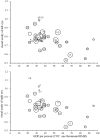Visual acuity of young men in China: Results from 3 national cross-sectional surveys from 1974 to 2012
- PMID: 30608434
- PMCID: PMC6344200
- DOI: 10.1097/MD.0000000000013966
Visual acuity of young men in China: Results from 3 national cross-sectional surveys from 1974 to 2012
Abstract
The prevalence of low vision has increased in China especially among youth population, which is an important public health issue. The trend on the prevalence of subnormal visual acuity and updated information is essential to quantify health effects and to prompt decision makers to prioritize action and assess the effectiveness of measures. Therefore, the study aimed to analyze the prevalence and geographical distribution of visual acuity level among young men in China based on 3 national cross-sectional surveys from 1974 to 2012.The data on visual acuity of young men were collected from 3 national surveys among military recruit youth conducted in 1974, 2001, and 2012 by using a stratified cluster sampling method in China. The prevalence of visual acuity among military recruit youth during this period was analyzed by region, year, age, and economic level.A total of 139,929, 72,894, and 58,106 young men were included, covering all 31 provinces of mainland of China, from the 3 national surveys respectively. The prevalence of subnormal visual acuity had geographic diversity and increased significantly from 1974 to 2012 (P < .05). The visual acuity level was negatively correlated with the age (17-23 years) in 2012 (P < .05). Furthermore, the prevalence of subnormal visual acuity was positively correlated with the gross domestic product in 31 provinces of China (P ≤ .001).The prevalence of subnormal visual acuity increased with economic development among young men from 1974 to 2012, with distinct variation among geographic areas in China. Furthermore, subnormal visual acuity was increasingly prevalent with age and warrant public health attention.
Conflict of interest statement
The authors have no conflicts of interest to disclose.
Figures



Similar articles
-
Body Mass Index of Young Men in China: Results From Four National Surveys Conducted Between 1955 and 2012.Medicine (Baltimore). 2016 Feb;95(6):e2829. doi: 10.1097/MD.0000000000002829. Medicine (Baltimore). 2016. PMID: 26871856 Free PMC article.
-
Visual impairment and blindness in spanish adults: geographic inequalities are not explained by age or education.Ophthalmology. 2014 Jan;121(1):408-416. doi: 10.1016/j.ophtha.2013.07.017. Epub 2013 Sep 17. Ophthalmology. 2014. PMID: 24053998
-
Association of Visual Impairment With Economic Development Among Chinese Schoolchildren.JAMA Pediatr. 2019 Jul 1;173(7):e190914. doi: 10.1001/jamapediatrics.2019.0914. Epub 2019 Jul 1. JAMA Pediatr. 2019. PMID: 31058915 Free PMC article.
-
Prevalence of blindness and low vision: a study in the rural Heilongjiang Province of China.Clin Exp Ophthalmol. 2012 Jul;40(5):484-9. doi: 10.1111/j.1442-9071.2011.02682.x. Epub 2011 Nov 21. Clin Exp Ophthalmol. 2012. PMID: 21902783
-
Review of the publications of the Nigeria national blindness survey: methodology, prevalence, causes of blindness and visual impairment and outcome of cataract surgery.Ann Afr Med. 2012 Jul-Sep;11(3):125-30. doi: 10.4103/1596-3519.96859. Ann Afr Med. 2012. PMID: 22684129 Review.
Cited by
-
Poor Uncorrected Visual Acuity and Association With Sleep Duration and Screen Time: A Dose-Response Relationship Study.Dose Response. 2021 Oct 11;19(4):15593258211042161. doi: 10.1177/15593258211042161. eCollection 2021 Oct-Dec. Dose Response. 2021. PMID: 34658684 Free PMC article.
References
-
- World Health Organization. Universal Eye Health: A Global Action Plan. 2013;Geneva, Switzerland: World Health Organization, 2014-2019.
-
- Xie HL, Xie ZK, Ye J, et al. Analysis of correlative factors and prevalence on China's youth myopia [in Chinese]. Zhonghua Yi Xue Za Zhi 2010;90:439–42. - PubMed
-
- Tsai DC, Fang SY, Huang N, et al. Myopia development among young schoolchildren: the myopia investigation study in Taipei. Invest Ophthalmol Vis Sci 2016;57:6852–60. - PubMed
-
- Lee SJ, Urm SH, Yu BC, et al. The prevalence of high myopia in 19 year-old men in Busan, Ulsan and Gyeongsangnam-do [in Korean]. J Prev Med Public Health 2011;44:56–64. - PubMed
-
- Gupta N, Kocur I. Chronic eye disease and the WHO Universal Eye Health Global Action Plan 2014-2019. Can J Ophthalmol 2014;49:403–5. - PubMed
Publication types
MeSH terms
LinkOut - more resources
Full Text Sources

